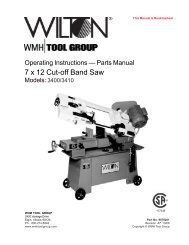This Rigger's Handbook is dedicated to Theodore C - Igor Chudov
This Rigger's Handbook is dedicated to Theodore C - Igor Chudov
This Rigger's Handbook is dedicated to Theodore C - Igor Chudov
Create successful ePaper yourself
Turn your PDF publications into a flip-book with our unique Google optimized e-Paper software.
Wire Ropes<br />
While there <strong>is</strong> a possibility, there <strong>is</strong><br />
likelihood that an application can be<br />
found for which there <strong>is</strong> a prec<strong>is</strong>ely<br />
suitable wire rope – one that can<br />
sat<strong>is</strong>fy every indicated requirement.<br />
As with all engineering design<br />
problems, feasible solutions demand<br />
comprom<strong>is</strong>e <strong>to</strong> some degree. At times,<br />
it becomes necessary <strong>to</strong> settle for less<br />
than optimum res<strong>is</strong>tance <strong>to</strong> abrasion<br />
in order <strong>to</strong> obtain maximum flexibility;<br />
the latter being a more important<br />
requirement for the given job. A<br />
typical example of th<strong>is</strong> kind of trade-off<br />
would be in selecting a highly flexible<br />
rope on an overhead crane.<br />
Conversely, in a haulage installation, a<br />
rope with greater res<strong>is</strong>tance <strong>to</strong><br />
abrasion would be chosen despite the<br />
fact that such ropes are markedly less<br />
flexible.<br />
Two compelling fac<strong>to</strong>rs that govern<br />
most dec<strong>is</strong>ions as <strong>to</strong> the selection of a<br />
wire rope are: abrasion res<strong>is</strong>tance,<br />
and res<strong>is</strong>tance <strong>to</strong> bending fatigue.<br />
Striking a proper balance with respect<br />
<strong>to</strong> these two important character<strong>is</strong>tics<br />
demands judgment of a very high<br />
order. A graphic presentation of just<br />
such compar<strong>is</strong>on of qualities between<br />
the most widely used rope<br />
constructions and others <strong>is</strong> given by<br />
means of X-chart.<br />
Referring <strong>to</strong> th<strong>is</strong> chart when selecting<br />
a rope, the mid-point (at the X) comes<br />
closest <strong>to</strong> an even balance between<br />
abrasion res<strong>is</strong>tance and res<strong>is</strong>tance <strong>to</strong><br />
bending fatigue. Reading up or down<br />
along either leg of the X, the inverse<br />
relationship becomes more apparent<br />
as one quality increases and the other<br />
decreases.<br />
EFFECT OF SHEAVE SIZE<br />
Wire ropes are manufactured in a<br />
great variety of constructions <strong>to</strong> meet<br />
the varying demands of wire rope<br />
usage. Where abrasion <strong>is</strong> an<br />
important fac<strong>to</strong>r, the rope must be<br />
made of a coarse construction<br />
containing relatively large wires. In<br />
other cases, the great amount of<br />
bending <strong>to</strong> which the rope <strong>is</strong> subjected<br />
<strong>is</strong> more important. Here, a more<br />
flexible construction, containing many<br />
relatively small wires, <strong>is</strong> required. In<br />
either case, however, if the rope<br />
operates over inadequate size<br />
sheaves, the severe bending stresses<br />
imposed will cause the wires <strong>to</strong> break<br />
from fatigue, even though actual wear <strong>is</strong><br />
slight. The smaller the diameter of the<br />
sheave, the sooner these fatigue breaks<br />
will occur and the shorter rope life<br />
becomes.<br />
Another undesirable effect of small<br />
sheaves <strong>is</strong> accelerated wear of both<br />
rope and sheave groove. The pressure<br />
per unit area of rope on sheave groove<br />
for a given load <strong>is</strong> inversely proportional<br />
<strong>to</strong> the size of the sheave. In other<br />
words, the smaller the sheave the<br />
greater the rope pressure per unit area<br />
on the groove. Both sheaves and rope<br />
life can obviously be prolonged by using<br />
the proper diameter sheave for the size<br />
and construction of rope.<br />
NUMBER OF OUTSIDE WIRES PER STRAND<br />
LEAST RESISTANCE TO BENDING FATIGUE GREATEST<br />
LEAST RESISTANCE TO ABRASION GREATEST<br />
HEADQUARTERS: 55 James E. Casey Drive • Buffalo, NY 14206 PHONE: 716.826.2636 FAX: 716.826.4412 www.hanessupply.com<br />
130<br />
Sheave diameter can also influence<br />
rope strength. When a wire rope <strong>is</strong><br />
bent around a sheave, there <strong>is</strong> a loss<br />
of effective strength due <strong>to</strong> the inability<br />
of the individual strands and wire <strong>to</strong><br />
adjust themselves entirely <strong>to</strong> their<br />
changed position. Tests show that rope<br />
strength efficiency decreases <strong>to</strong> a<br />
marked degree as the sheave diameter<br />
<strong>is</strong> reduced with respect <strong>to</strong> the diameter<br />
of the rope.<br />
Therefore, it <strong>is</strong> evident that a definite<br />
relationship ex<strong>is</strong>ts between rope<br />
service and sheave size. As a guide <strong>to</strong><br />
rope users, wire rope manufacturers<br />
have establ<strong>is</strong>hed standards for various<br />
rope constructions. To secure the most<br />
economical service, it <strong>is</strong> important that<br />
the suggested size of sheaves given<br />
below be used.<br />
The wire rope industry refers <strong>to</strong> th<strong>is</strong> as the X-chart. It serves <strong>to</strong> illustrate the<br />
inverse relationship between abrasion res<strong>is</strong>tance and res<strong>is</strong>tance <strong>to</strong> bending<br />
fatigue in a representative number of the most widely used wire ropes.<br />
6<br />
9<br />
10<br />
12<br />
12<br />
12<br />
14<br />
16<br />
18<br />
YOUR SLING AND RIGGING SPECIALIST<br />
ABRASION AND BENDING<br />
THE "X CHART": ABRASION RESISTANCE VS. BENDING-FATIGUE RESISTANCE<br />
6 X 7<br />
6 X 19 S<br />
6 X 21 FW<br />
Flattened<br />
Strand<br />
6 X 25 FW<br />
6 X 31 WS<br />
6 X 36 WS<br />
6 X 49 FWS<br />
6 X 64 SFWS<br />
PROPER SHEAVE AND DRUM SIZES<br />
CONSTRUCTION<br />
SUGGESTED<br />
D/d* RATIO<br />
MINIMUM<br />
D/d*RATIO<br />
6 x 7<br />
19 x 7 or 18 x 7<br />
72 42<br />
Rotation Res<strong>is</strong>tant 51 34<br />
6 x 19 Seale 51 34<br />
6 x 27 H flattened strand 45 30<br />
6 x 31 V flattened strand 45 30<br />
6 x 21 filler wire 45 30<br />
6 x 25 filler wire 39 26<br />
6 x 31 Warring<strong>to</strong>n Seale 39 26<br />
6 x 36 Warring<strong>to</strong>n Seale 35 23<br />
8 x 19 Seale 41 27<br />
8 x 25 filler wire 32 21<br />
6 x 41 Warring<strong>to</strong>n Seale 32 21<br />
6 x 42 filler 21 14
















